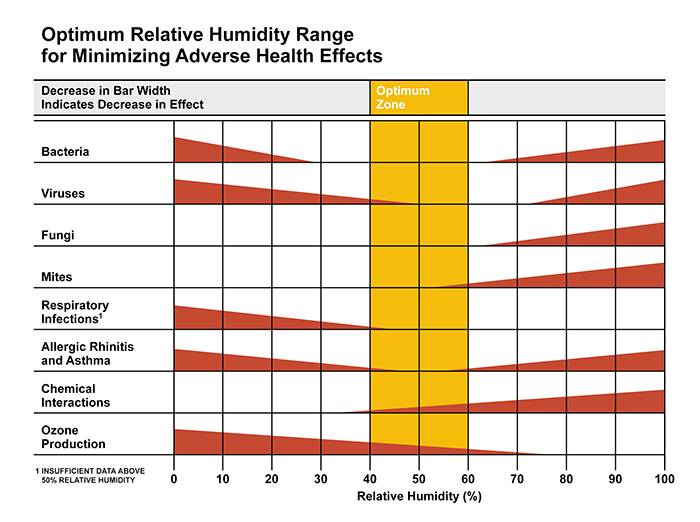In many parts of the U.S., homeowners with basements have to manage rising humidity levels for most of the cooling season. It is not uncommon for such individuals to have a dehumidifer running full-throttle in the basement from April through October. High indoor humidity levels has been associated with the growth of fungi, such as mold, among other irritants. The EPA suggests keeping indoor relative humidity (RH) under 60 percent in order to effectively minimize mold growth. The EPA cites an ideal relative humidity between 30-50 percent; however, in reality, it can be a struggle to maintain such a low RH range in spaces susceptible to taking on moisture.
In fact, mold growth is only one of several indoor environmental contaminants whose growth correspond to indoor relative humidity levels. Figure 1 is an adaptation of a frequently cited chart by Anthony V. Arundel et al. (1986) that illustrates the relationship between indoor RH and the effect of several indoor environmental pollutions sources.
|
|
|
Figure 1: Optimum relative humidity range for minimizing adverse health effects. |
Arundel et al. (1986) draw several direct health effects of indoor humidity levels:
- Both very high and very low relative humidities may cause thermal discomfort due to perceived air temperatures.
- Extremely low RH (<20 percent) may cause eye irritation.
- Moderate / high RH may reduce the severity of asthma.
Interestingly, Arundel et al. cited little experimental evidence that mucous membranes are adversely affected by low indoor humidity levels. They stated that such experiences may be the result of the direct effect of RH on the mucous membranes of individuals with bronchial construction, rhinitis, or cold and influenza related symptoms. Moreover, Arundel et al. found low RH to improve the survival of rhinoviruses and influenza virus and human rotavirus on hard surfaces.
Arundel et al. also cite several indirect health effects of indoor humidity levels:
- High RH fosters the growth of fungi and mites.
- Both high and low RH can result in certain types of bacteria and virus growth.
- Formaldehyde, sulfur, nitrogen dioxides, and other chemical respiratory irritants may be more severe in high humidity environments.
- Indoor ozone levels are enhanced by low relative humidity.
It is important to recognize that Figure 1 does not represent quantitative data. A review of the available data on the indirect health effects of indoor humidity shows that the effects do not uniformly increase or decrease with RH levels. According to Arundel et al., the relative humidity range for minimizing as many adverse health effects as possible appears to be between 40 and 60 percent.
Reference:
Arundel, A.V., et al. "Indirect Health Effects of Relative Humidity in Indoor Environments." Environmental Health Perspectives. Vol. 65, pp. 351-361 (1986).


